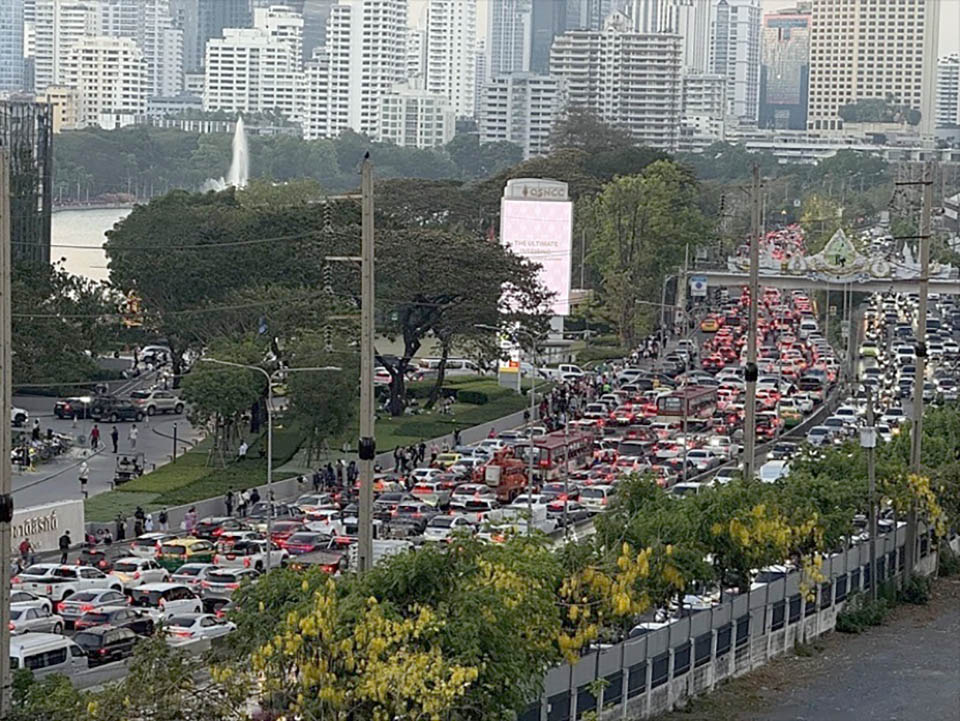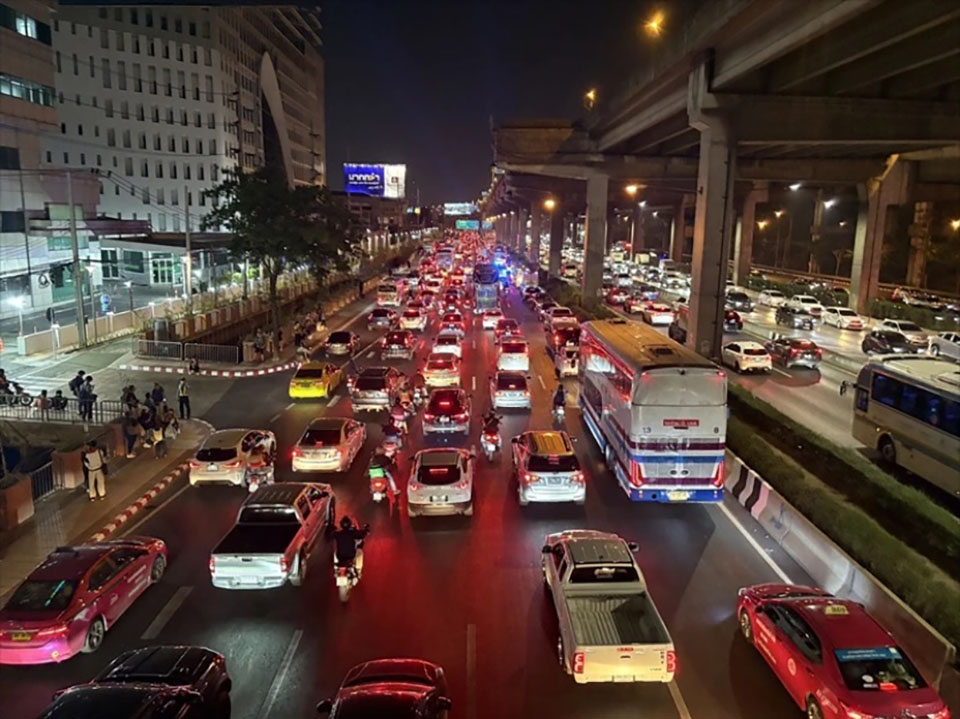
BANGKOK, Thailand – The 8.2-magnitude earthquake that struck Myanmar on March 28, was the strongest in 95 years. The quake, with a depth of 10 kilometers, sent tremors across multiple regions in Thailand, particularly in the North, Central Thailand, and Bangkok. The capital city suffered severe damage, with high-rise buildings affected and significant casualties reported.
The disaster caused widespread panic. People evacuated from tall buildings, businesses shut down, and public institutions closed, leading to a surge in emergency travel. Many rushed to return home or find safer locations, resulting in citywide traffic paralysis.
In Chiang Mai, congestion levels rose over 50% compared to normal conditions, while in Bangkok, traffic moved at an average speed of only 13 km/h. Even eight hours after the earthquake, the city’s transportation system had yet to return to normal.
A Transport Crisis Amid Disaster
The sudden spike in travel demand caused severe gridlock. Private car users faced heavy traffic jams, but those relying on public transport had even fewer options.
Bangkok’s electric train system was suspended for over 10 hours, with some lines shutting down for even longer due to safety concerns. This left over a million daily commuters stranded.
Buses, which were supposed to be an alternative, struggled with an insufficient number of trips. Despite government efforts to allocate more vehicles, the unpredictability of demand and traffic congestion rendered public buses ineffective.
While passenger ferries continued to operate, they were not a primary mode of transportation and could not accommodate the sudden influx of commuters. Meanwhile, ride-hailing services, taxis, and motorcycle taxis faced shortages, causing fares to skyrocket by two to three times the normal rates.
With limited options, many had no choice but to walk several kilometers to reach their destinations.
This situation highlighted not just a traffic standstill but a complete collapse of the public transport system. While this might not be critical in a minor disaster, it raises serious concerns about Thailand’s preparedness for more severe crises.

Predictable Yet Unpredictable Travel Patterns
Disasters drive mass evacuations. Some, like floods and storms, can be anticipated, allowing the government to pre-position resources and guide people to safer zones. However, earthquakes and fires strike without warning, requiring preemptive planning and emergency drills well in advance.
Regardless of whether a disaster is predictable, an effective emergency response must ensure:
-Clear evacuation routes and safe zones
-Efficient transport coordination to move affected individuals and emergency aid
-Public awareness of risk areas and safety measures
Without structured evacuation plans, panic-driven movement can lead to chaotic, inefficient, and even dangerous situations.
Lessons from Abroad: How Should Public Transport Respond?
The absence of a comprehensive disaster response plan left Thai commuters without options. The suspension of electric trains without clear timelines for resumption made travel planning impossible. Road congestion worsened as collapsed structures blocked key routes, such as Din Daeng, Chatuchak, and Rama II. Expressway entrances and exits were closed due to falling debris from nearby construction sites, further complicating evacuation efforts.
In contrast, Japan, a country frequently hit by natural disasters, has a highly organized emergency transport plan. Key strategies include:
-Maintaining reduced-speed train services in minor earthquakes (under 15 km/h) while conducting continuous safety checks
-Pre-assessing transportation demand and ensuring backup mobility options, including emergency bus fleets and designated evacuation routes
Thailand, however, lacks this level of preparedness. The indefinite suspension of train services, without clear safety assessment timelines, left commuters stranded.
Is Thailand’s Disaster Response Plan Effective?
Thailand’s disaster response is governed by the 2007 Disaster Prevention and Mitigation Act, which provides a national framework for disaster management. However, the country’s response has historically been geared towards long-term disaster preparedness, rather than rapid emergency action.
The slow communication from authorities worsened public panic. The Meteorological Department took over 30 minutes to issue an official earthquake alert, and there was no immediate guidance on evacuation procedures. Many relied on social media for updates, which led to widespread misinformation and increased fear.
Even government SMS alerts, which could have provided real-time updates, took over five hours to reach the public, with some people never receiving them at all.
The panic-driven rush to evacuate, combined with a collapsed transport system, completely paralyzed Bangkok. If the earthquake had been even stronger, the capital could have faced an unimaginable catastrophe.

What Should the Government Do Next?
To prevent such chaos in future disasters, authorities must:
-Develop a structured emergency transport plan, ensuring backup options for when trains or roads are disrupted
-Improve real-time public communication through fast and reliable alert systems
-Conduct emergency evacuation drills to educate citizens on proper procedures
-Coordinate with ride-hailing services, taxis, and buses to ensure fair pricing and availability during crises
Thailand’s next disaster is not a matter of “if,” but “when.” Without a clear, structured response plan, the nation risks facing another transportation collapse in the next major crisis.










